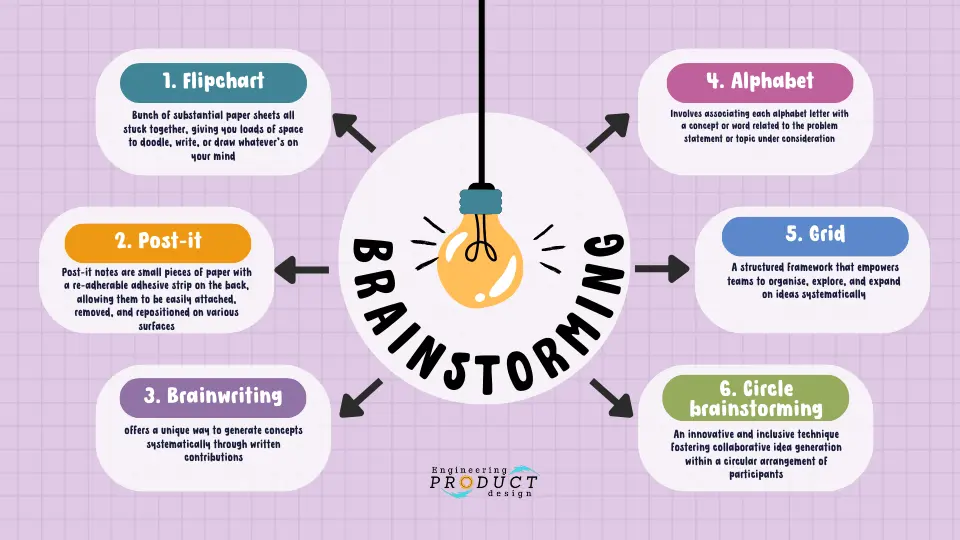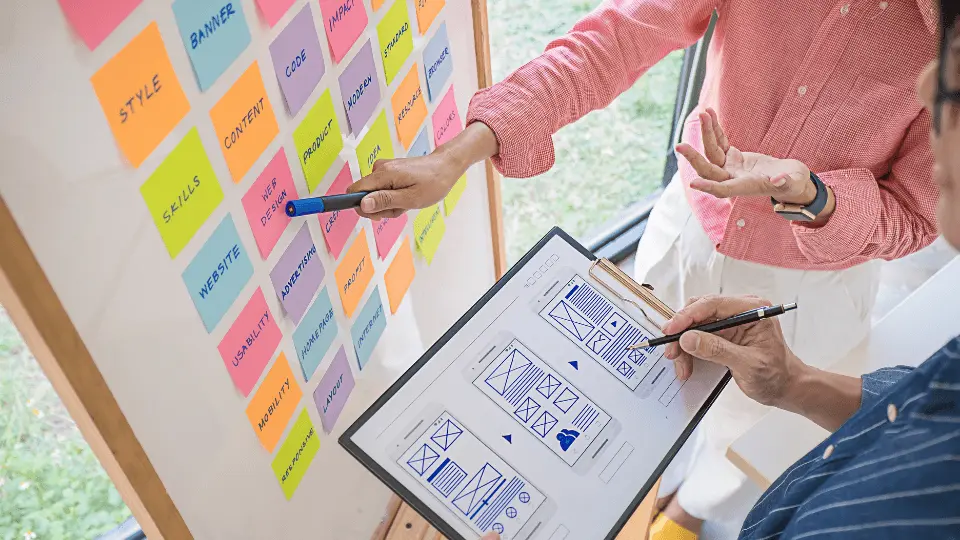Discover six powerful brainstorming techniques for innovative product ideas. Unlock creativity and drive concept generation in new product development.
Contents covered in this article
What is Brainstorming?
Brainstorming is a collaborative technique or method to generate creative ideas or solutions within a group setting. Participants freely express their thoughts, building upon each other’s suggestions without criticism towards one objective. This technique encourages divergent thinking, fostering innovation and problem-solving through a non-judgmental, open exchange of diverse perspectives and concepts.
In 1953, advertising executive Alex Osborn introduced “brainstorming” through his book “Applied Imagination: Principles and Procedures of Creative Thinking” as he realised conventional meetings stifled new ideas. Seeking a method for unrestricted thinking, he aimed to provide a space where individuals could innovate freely, unhampered by critique or limitations.

According to Lucidchart.com, we should remember these four fundamental brainstorming rules when using any brainstorming techniques.
- Focus on quantity
- Withhold criticism
- Welcome unusual ideas
- Combine and improve ideas.

Brainstorming is the heartbeat of innovation & creativity, which are the cornerstones of Product concept generation. Having the right brainstorming techniques can make all the difference when brainstorming product ideas. Whether a team activity or an individual process, structured brainstorming is crucial in developing many ideas. In idea generation, here are six fantastic tools that can turn your brainstorming group activities into idea goldmines.
| Technique | When to Use | Number of People | Application |
|---|---|---|---|
| Flipchart | Idea visualisation & iteration, especially for new product ideas and problem-solving | 4-8 | Group idea generation, concept mapping |
| Post-it | Idea sorting & clustering. Useful for fishbone diagram to identify possible causes of a problem | 3-10+ | Organizing thoughts, affinity mapping, voting |
| Brainwriting | Simultaneous idea generation. Applicable for feature-based product design issues | 4-8 | Silent idea generation, reducing dominance |
| Alphabet | Structured idea generation. It can be an excellent tool for exploring large system-based or multiple families of product ideas | 3-10+ | Sequential idea exploration, ordered brainstorming |
| Grid | Categorization & prioritisation. Suitable for large groups | 4-10+ | Sorting ideas based on criteria, evaluating options |
| Circle brainstorming | Encouraging diverse perspectives. Suitable for large groups exploring ideas for common issues | 5-12+ | Stimulating free-flowing ideas, inclusive discussions |
Flipchart
There’s nothing quite like an excellent flipchart regarding brainstorming. It’s a big paper pad on a stand where you can let your creativity loose. Don’t be fooled by its simplicity. This is a game-changer for getting ideas flowing when working together.

So, what’s the deal with flipcharts? Well, they’re like a bunch of substantial paper sheets all stuck together, giving you loads of space to doodle, write, or draw whatever’s on your mind. They’re easy to move around and keep things straightforward, which makes them perfect for any brainstorming session. Plus, they’re hands-on and visual, getting everyone in on the creative action.
How to use Flipchart for brainstorming
Utilising a flipchart for concept generation involves a structured yet open approach.
- Prepare the space – Set up the flipchart in a visible and accessible area. Ensure markers, pens, and any other required tools are readily available.
- State the objective – Clearly define the problem or concept to be explored. Write it at the top of the flipchart to provide focus and ensure everybody understands the goal.
- Free expression – Encourage participants to contribute ideas freely. As thoughts emerge, jot them down on the flipchart. Utilise visuals, mind maps, or diagrams to connect and illustrate concepts. At this stage, do not evaluate the ideas.
- Group and refine ideas – As ideas accumulate, group related ones together as ideas accumulate. Use colour-coding or different sections of the flipchart to organise thoughts. Discuss and refiGroupively. Again, avoid detailed evaluation at this stage.
- Encourage visual representation – Use drawings, diagrams, or symbols to augment understanding and facilitate diverse thinking styles.
- Summarise and prioritise – Summarise critical points and identify priority areas as the session progresses. This helps distil the most promising concepts for further development in the following concept generation stage.
Things to avoid:
While the flipchart is a versatile tool, certain pitfalls can hinder its effectiveness:
- Overcrowding – Avoid cluttering the flipchart with too many ideas. It can overwhelm and dilute the focus.
- Dominant voices – Ensure that the brainstorming session remains inclusive, allowing all participants to contribute without dominance by a select few.
- Lack of focus – Straying too far from the main objective can lead to tangential discussions. Keep steering the conversation back to the central concept.
Benefits and Limitations of Flipcharts
Benefits
- Visual stimulation – Visual representation aids comprehension and sparks creativity.
- Collaborative engagement – Encourages participation and involvement from all members.
- Flexibility – Offers a flexible canvas for diverse thinking styles and idea organisation.
Limitations
- Limited space – Constraints of space might restrict the number of ideas that can be displayed at once.
- Permanence of ideas – The inability to easily modify or erase ideas once they’re on paper might hinder fluidity in ideation.
- Mobility challenges – Moving or preserving the flipchart for later reference might take some work.
Simply put, the flipchart is a superstar among brainstorming tools. It’s all about getting interactive and bringing your ideas to life. But here’s the trick: you must use it right to make the most of it. Keep your eyes on the main idea, make sure everyone’s pitching in, and welcome all sorts of ideas to make those creative juices flow.
Post-it
Only some brainstorming techniques like Post-it Notes offer flexibility and simplicity in brainstorming and idea generation. These small, adhesive-backed papers have become an iconic symbol of creative collaboration, facilitating the exploration and development of concepts in diverse settings.

Post-it notes are small pieces of paper with a re-adherable adhesive strip on the back, allowing them to be easily attached, removed, and repositioned on various surfaces. Their compact size and vibrant colours make them an ideal tool for capturing, organising, and sharing ideas in a visually engaging manner.
How to use Post-it for brainstorming
Employing Post-it notes for concept generation involves a dynamic and fluid process:
- Preparation – Equip participants with various Post-it notes in different colours and sizes. Ensure a clear and visible workspace to affix the notes, such as a whiteboard or a wall.
- State the objective – Define the problem statement or concept to be explored and write it at the top of the workspace. This provides a focal point for brainstorming efforts.
- Generating ideas – Encourage participants to write individual ideas or concepts on separate Post-it notes. Each idea should be concise, clear, and written legibly.
- Affinity mapping – As ideas accumulate, group related Post-it notes together based on their thematic similarities or connections. This process, known as affinity mapping or clustering, helps identify patterns and relationships among ideas.
- Discussion and refinement – Facilitate discussions around the clustered ideas. Encourage participants to elaborate on, combine, or refine concepts by moving or repositioning Post-it notes as needed.
- Prioritisation and summary – Once clusters are formed and discussions evolve, collectively prioritise the most promising ideas within each group. Summarise these key points to guide further development.
Things to avoid
While Post-it notes are an invaluable tool, certain practices can hinder their effectiveness:
- Overcrowding – Avoid overwhelming the workspace with excessive notes, which can dilute the focus and impede clarity.
- Lack of diversity in contributions – Ensure all participants have equal opportunities to contribute ideas to ensure a balanced pool of concepts.
- Disorganised clustering – Carefully organise and regroup the Post-it notes to ensure clarity and interpretation of the connections between ideas.
Benefits and Limitations of Post-it Notes
Benefits
- Flexibility and mobility – Easy to move, rearrange, and group, allowing for dynamic brainstorming sessions.
- Visual representation – Encourages a visual representation of ideas, aiding comprehension and stimulating creativity.
- Accessibility and collaboration – Facilitate inclusive participation and engagement among team members.
Limitations
- Limited space – Space constraints might limit the number of ideas displayed simultaneously.
- Risk of misplacement – Notes might get misplaced or fall off, potentially disrupting the session flow.
- Dependency on physical presence – Relies on proximity for collaboration, limiting remote participation.
Post-it notes accelerate collaborative thinking, offering product design teams a dynamic idea generation and concept development platform. Their versatility in organising thoughts, promoting visual thinking, and encouraging active participation makes them invaluable for teams seeking to innovate and explore new concepts. However, ensuring a balanced and diverse contribution of ideas while maintaining an organised workspace is essential for harnessing the full potential of Post-it notes in concept generation.
Brainwriting
Brainwriting stands as a structured and collaborative approach in brainstorming methodologies, fostering the exchange and evolution of ideas within a group setting. This technique, often underrated yet powerful, offers a unique way to generate concepts systematically through written contributions.
Brainwriting is a brainstorming technique that emphasises written contributions from participants within a group setting. Unlike traditional verbal brainstorming sessions, brainwriting encourages individuals to generate and build upon ideas independently and concurrently.
How to use Brainwriting for Brainstorming
Employing Brainwriting for concept generation involves a structured yet free-flowing approach:
- Preparation – Set the stage by defining the problem statement or concept to be explored. Ensure each participant can access writing materials such as paper, pens, or digital platforms for virtual Brainwriting sessions. Download a Brainwriting template here.
- Silent idea generation – Participants start by independently jotting down their ideas or concepts within a specified time frame. Emphasise the importance of clarity and brevity in expressing ideas.
- Idea exchange and expansion – Participants pass their written contributions to others, which build upon or modify these ideas after the initial round. This exchange continues, allowing each idea to evolve through diverse perspectives.
- Review and discussion – Collect and review the evolved concepts. Encourage a group discussion to delve deeper into the refined ideas, seeking clarification and identifying potential synergies or complementary elements.
- Consolidation and prioritisation – Identify and consolidate the most promising concepts that have emerged through Brainwriting. Prioritise these concepts based on relevance, feasibility, and innovation potential.
Things to avoid
While Brainwriting offers a structured approach to brainstorming, certain pitfalls can hinder its effectiveness:
- Dominant voices – Ensure all participants contribute actively to prevent the dominance of a select few, encouraging a diverse pool of ideas.
- Lack of time management – Strictly manage time for each round to prevent sessions from dragging on, maintaining momentum and focus.
- Disregarding contribution quality – Emphasize the quality of contributions, ensuring clarity and relevance in written ideas.
Benefits and limited of Brainwriting
Benefits
- Equitable participation – Provides an unbiased platform for all participants to contribute ideas without the dominance of vocal personalities.
- Diverse perspectives – Facilitates the generation of a wide array of concepts by amalgamating individual viewpoints.
- Structured evolution of ideas – Offers a systematic approach for ideas to evolve and grow through multiple iterations.
Limitations
- Time Constraints: Time limits for each round might restrict the depth or elaboration of ideas.
- Potential Lack of Spontaneity – The written nature of Brainwriting might hinder the immediate exchange of thoughts and spontaneous discussions.
- Dependence on Written Communication – This might pose challenges for participants who prefer verbal expression over written forms.
Brainwriting is a structured yet inclusive method for generating and evolving ideas within a group setting. Its emphasis on written contributions enables diverse perspectives to converge, fostering the evolution of concepts through multiple iterations. However, ensuring active participation, managing time effectively, and balancing structured evolution with spontaneity is crucial for maximising Brainwriting’s potential as a concept generation tool.
Alphabet
Amidst the myriad brainstorming techniques, harnessing the Alphabet as a tool for creativity stands out as an unconventional yet effective method. By structuring brainstorming sessions around the alphabet, teams can unlock a structured yet creative approach to generating concepts.
The Alphabet technique involves associating each alphabet letter with a concept or word related to the problem statement or topic under consideration. Participants then use these associations as prompts to generate ideas corresponding to each letter.
How to use Alphabet for Brainstorming
Employing the Alphabet technique for concept generation involves a systematic approach:
- Preparation and alphabet association – Begin by associating each letter of the alphabet with relevant keywords, concepts, or themes related to the topic. This step ensures a broad range of associations for idea generation.
- Letter-by-Letter Ideation – Start the brainstorming session by focusing on a specific letter. Encourage participants to generate ideas corresponding to that letter’s associated concept. For instance, if ‘A’ is associated with “Automation,” ideas related to automated processes or systems can be explored.
- Mindful exploration – As ideas for each letter emerge, encourage diverse perspectives and creativity. Participants should explore various angles, applications, or implications associated with the concept represented by the letter.
- Progression through the alphabet – Continue moving through each alphabet letter. Each letter serves as a unique prompt, guiding the ideation process and stimulating different avenues of thought.
- Group discussion and refinement – Once ideas for each letter are generated, engage in a group discussion to evaluate, refine, and elaborate on the concepts. Identify connections between ideas from different letters, fostering a holistic view of the generated concepts.
Things to avoid
While Alphabet brainstorming provides a structured framework, certain pitfalls can hinder its effectiveness:
- Rigid adherence to association – Avoid limiting ideas strictly to the associated concept for each letter. Encourage flexibility and exploration of diverse interpretations.
- Lack of diversity in associations – Ensure the associations for each letter cover a broad spectrum of relevant concepts or keywords to stimulate comprehensive ideation.
- Overlooking uncommon letters – Pay attention to letters less frequently used in brainstorming, ensuring thorough exploration and avoiding missing potential ideas associated with these letters.
Benefits and Limitations of Alphabet Brainstorming
Benefits
- Structured guidance – Provides a systematic approach that guides idea generation through a defined framework.
- Diverse ideation – Promotes diverse thinking by offering distinct prompts for each letter, encouraging exploring various concepts.
- Holistic view – A comprehensive view of the topic is facilitated by covering a broad spectrum of concepts and associations.
Limitations
- Potential limitations – Restriction to associations for each letter might limit the scope of imagination for specific topics or concepts.
- Need for varied Associations – Requiring diverse and relevant associations for each letter demands careful preparation and curation beforehand.
- Risk of overlooking connections – Rapid progression through the alphabet might ignore potential connections or intersections between ideas associated with different letters.
The Alphabet technique offers a structured yet versatile approach to concept generation, guiding participants through a curated set of associations for each letter. By providing a framework for exploration, it stimulates diverse thinking. It enables teams to delve deeply into various facets of a topic. However, maintaining flexibility, ensuring diverse associations, and identifying connections between concepts from different letters are crucial for maximising the effectiveness of Alphabet brainstorming in concept generation.
Grid
In the landscape of brainstorming methodologies, the Grid emerges as a structured framework that empowers teams to organise, explore, and expand on ideas systematically. By employing a grid-based approach, teams can unlock the potential for comprehensive concept generation.
In brainstorming, a grid is a structured framework consisting of rows and columns, creating cells that serve as containers for ideas, concepts, or related information. These cells can be used to organise, categorise, and visualise concepts in a structured manner.
How to use a Grid for Brainstorming
Leveraging a grid for concept generation involves a systematic and structured process:
- Grid design and parameters – Define the parameters or categories relevant to the concept or problem statement. Create a grid structure with rows and columns that align with these parameters. For instance, parameters include features, target audience, cost, and feasibility of exploring a product concept.
- Idea generation and placement – Encourage participants to populate the grid cells with ideas, concepts, or information relevant to each parameter. Each cell becomes a space to input or expand upon ideas related to that specific category.
- Interconnection and expansion – As ideas are placed within the grid, encourage participants to identify cell connections or relationships. This process fosters the expansion and evolution of ideas by exploring intersections and overlaps between categories.
- Structured discussion and analysis -Engage in structured discussions around the grid, exploring the content within each cell and the connections between cells. Analyse the relationships between different categories, seeking opportunities for synergy or refinement.
- Iterative refinement – Continuously refine and update the grid as new ideas emerge or existing concepts evolve. Encourage participants to add, modify, or reposition ideas within the grid based on evolving discussions and insights.
Things to avoid
While a grid provides a structured framework, certain practices can impede its effectiveness:
- Rigid categorisation – Avoid overly strict categorisation that might limit the exploration of ideas or connections between categories.
- Overcomplication – Steer clear of making the grid overly complex, as this can overwhelm participants and hinder the focus on core concepts.
- Neglecting flexibility – Ensure the grid allows for fluidity and adaptation, including new ideas or restructuring categories as needed.
Benefits and limitations of using a Grid
Benefits
- Structured organisation – Offers a systematic and organised framework for categorising and exploring ideas.
- Visual clarity – Provides a visual representation of concepts and their relationships, aiding comprehension and analysis.
- Facilitates analysis and synthesis – Enables in-depth analysis of connections between different categories, fostering synthesis and innovation.
Limitations
- Potential rigidity – The structured nature of the grid might limit free-flowing creativity or exploration.
- Complexity management – Managing complexity within the grid structure can be challenging and potentially overwhelm participants.
- Time-consuming – Elaborating grids or detailed categorisations consumes significant time, impacting the efficiency of brainstorming sessions.
Grid-based brainstorming offers a structured and organised approach to concept generation, enabling teams to explore, organise, and visualise ideas within a framework. Providing a systematic structure facilitates in-depth analysis and synthesis of concepts. However, balancing structure with flexibility, managing complexity, and ensuring the grid doesn’t stifle creativity are crucial for maximising the efficacy of grid-based brainstorming in concept generation.
Circle brainstorming
Circle brainstorming is an innovative and inclusive technique fostering collaborative idea generation within a circular arrangement of participants. This approach provides a structured yet dynamic platform for cultivating diverse concepts and perspectives.
Circle brainstorming involves participants gathering in a circular formation to collectively contribute ideas and insights. Each participant contributes an idea or thought, building upon the contributions of others as the circle progresses.
How to use Circle Brainstorming for Concept Generation
Employing circle brainstorming as a tool for concept generation involves a structured and collaborative process:
- Formation and introduction – Arrange participants in a circular configuration, ensuring everyone has a clear view of others within the circle. Introduce the problem statement or concept to be explored.
- Round-robin idea contribution – Initiate the brainstorming session by having each participant contribute an idea or thought related to the topic. Start from one point in the circle and progress sequentially, allowing each participant to build upon the ideas shared by others.
- Free-flowing discussions – As ideas are contributed, encourage brief discussions or elaborations on each idea. Participants can add nuances, ask clarifying questions, or offer supportive comments to further develop the concepts.
- Iterative rounds – Progress through multiple rounds within the circle, allowing each participant to contribute additional ideas or perspectives. This iterative process encourages a diverse range of concepts to emerge and evolve.
- Summarisation and reflection – Conclude the circle brainstorming session by summarising the key emerging concepts or themes. Encourage participants to reflect on the collective ideas and identify common threads or innovative insights.
Things to avoid
it’s essential to steer clear of specific pitfalls to ensure the effectiveness of circle brainstorming.
- Dominance of voices – Avoid allowing a few participants to dominate the conversation. Encourage equal participation to foster a wide array of perspectives.
- Lack of Focus – Ensure discussions align with the central concept or problem statement to prevent tangential or irrelevant contributions.
- Hesitation in contribution – Encourage a supportive environment where participants feel comfortable sharing ideas without hesitation or fear of judgment.
Benefits and limitations of circle brainstorming
Benefits
- Inclusivity and collaboration – Promote equal participation and cooperation among participants, fostering diverse ideas.
- Synergistic contributions – Enables the building upon and enhancement of ideas as they circulate within the group, fostering innovation through collective input.
- Dynamic interaction – Encourages real-time interactions and discussions, fostering an engaging and energetic brainstorming environment.
Limitations
- Time management – Without proper facilitation, discussions within the circle might extend, impacting the session’s time management.
- Potential overlap of ideas – Ideas contributed earlier might influence subsequent contributions, leading to a repetition or overlap of concepts.
- Uneven participation – Inequitable participation might occur if certain participants dominate the conversation or others are reluctant to contribute.
Circle brainstorming is a dynamic and collaborative method for concept generation, allowing for the collective exploration and evolution of ideas within a circular group setting. It thrives on inclusivity and engagement, leveraging the contributions of each participant to fuel the generation of diverse and innovative concepts. However, ensuring balanced participation, maintaining focus, and managing time effectively is critical for maximising the potential of circle brainstorming as a tool for concept generation.
Recommended reference
- Kelley, T., Littman, J. (2001). The Art of Innovation: Lessons in Creativity from Ideo, America’s Leading Design Firm. Profile Books Ltd.
- Osborn, A. (1953) ‘Applied Imagination: Principles and Procedures of Creative Problem-Solving,’ New York: Creative Education Foundation Press.
- Mootee, I. (2013). Design Thinking for Strategic Innovation. Wiley.
- Brown, T. (2009). Change by Design. Harper Business.
- Besant, Hanisha. “Alex Osborn and The Journey of Brainstorming.” Regent University, Alex Osborn and The Journey of Brainstorming